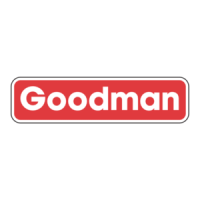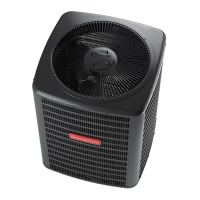What to do if Goodman Air Conditioner has too much air across indoor coil?
- DDonald GibbsSep 23, 2025
If there is too much air across the indoor coil of your Goodman Air Conditioner, reduce the blower speed.
What to do if Goodman Air Conditioner has too much air across indoor coil?
If there is too much air across the indoor coil of your Goodman Air Conditioner, reduce the blower speed.
What to do if Goodman Air Conditioner has overcharge of refrigerant?
If you have an overcharge of refrigerant in your Goodman Air Conditioner, recover part of the charge.
How to fix loose connection in Goodman GSC13024 Air Conditioner?
If your Goodman Air Conditioner has a loose connection, inspect the connection and tighten it.
How to test shorted or broken wires in Goodman GSC13024?
If your Goodman Air Conditioner has shorted or broken wires, test the circuits with an ohmmeter.
What to do if Goodman Air Conditioner has noncondensibles?
If your Goodman Air Conditioner has noncondensibles, recover the charge, evacuate, and recharge.
What to do if Goodman GSC13024 Air Conditioner has not enough air across indoor coil?
If there is not enough air across the indoor coil of your Goodman Air Conditioner, increase the blower speed and check the duct static pressure.
What to do if Goodman GSC13024 has undersized liquid line?
If the liquid line is undersized in your Goodman Air Conditioner, replace the line.
What to do if Goodman Air Conditioner has undersized suction line?
If the suction line is undersized in your Goodman Air Conditioner, replace the line.
How to test faulty fan relay in Goodman Air Conditioner?
If your Goodman Air Conditioner has a faulty fan relay, test the continuity of the coil and contacts.
How to test shorted or grounded compressor in Goodman GSC13024?
If your Goodman Air Conditioner compressor is shorted or grounded, test the motor windings.
Unit shipped with nitrogen/helium holding charge only; must be evacuated and charged.
Units with holding charge are for component replacement on existing systems.
Units must only be used as replacement components for pre-2010 installed systems.
Steps for connecting gauges, measuring temperature, and adjusting refrigerant charge.
Warning about high voltage and the need to disconnect power before servicing.
Specifies required technician level and provides warranty information.
Details shipping inspection, regulatory compliance, and installation clearances.
Guidelines for rooftop installation and safe handling of refrigerants.
Covers dangers of refrigerant exposure, cold, and EPA regulations.
Precautions for cylinders, system openings, and oil moisture.
Proper methods for routing lines, insulating them, and preventing contact.
Steps for cutting, cleaning, and preparing refrigerant tubing.
Steps for brazing refrigerant lines, including heat control and joint preparation.
Guidelines for leak testing using nitrogen and safety precautions.
Method for pressure testing the system using nitrogen and soapy water.
Steps for evacuating the system to 250 microns or less.
Warning about high voltage and proper wiring practices.
Guidelines on wire sizing for voltage drop and using copper conductors.
Instructions for opening service valves and tightening caps.
Guidance on adding refrigerant amount shown in table for the unit.
Procedure for adjusting charge on fixed orifice systems using superheat.
Procedure for adjusting TXV systems based on subcooling and superheat.
Table listing complaints, possible causes, and test methods.
Unit shipped with nitrogen/helium holding charge only; must be evacuated and charged.
Units with holding charge are for component replacement on existing systems.
Units must only be used as replacement components for pre-2010 installed systems.
Steps for connecting gauges, measuring temperature, and adjusting refrigerant charge.
Warning about high voltage and the need to disconnect power before servicing.
Specifies required technician level and provides warranty information.
Details shipping inspection, regulatory compliance, and installation clearances.
Guidelines for rooftop installation and safe handling of refrigerants.
Covers dangers of refrigerant exposure, cold, and EPA regulations.
Precautions for cylinders, system openings, and oil moisture.
Proper methods for routing lines, insulating them, and preventing contact.
Steps for cutting, cleaning, and preparing refrigerant tubing.
Steps for brazing refrigerant lines, including heat control and joint preparation.
Guidelines for leak testing using nitrogen and safety precautions.
Method for pressure testing the system using nitrogen and soapy water.
Steps for evacuating the system to 250 microns or less.
Warning about high voltage and proper wiring practices.
Guidelines on wire sizing for voltage drop and using copper conductors.
Instructions for opening service valves and tightening caps.
Guidance on adding refrigerant amount shown in table for the unit.
Procedure for adjusting charge on fixed orifice systems using superheat.
Procedure for adjusting TXV systems based on subcooling and superheat.
Table listing complaints, possible causes, and test methods.
| Cooling Capacity | 24, 000 BTU/h |
|---|---|
| SEER Rating | 13 |
| Compressor Type | Scroll |
| Refrigerant Type | R-410A |
| Tonnage | 2 tons |
| Voltage | 208/230 V |
| Phase | 1 |
| Sound Level | 76 dB |












